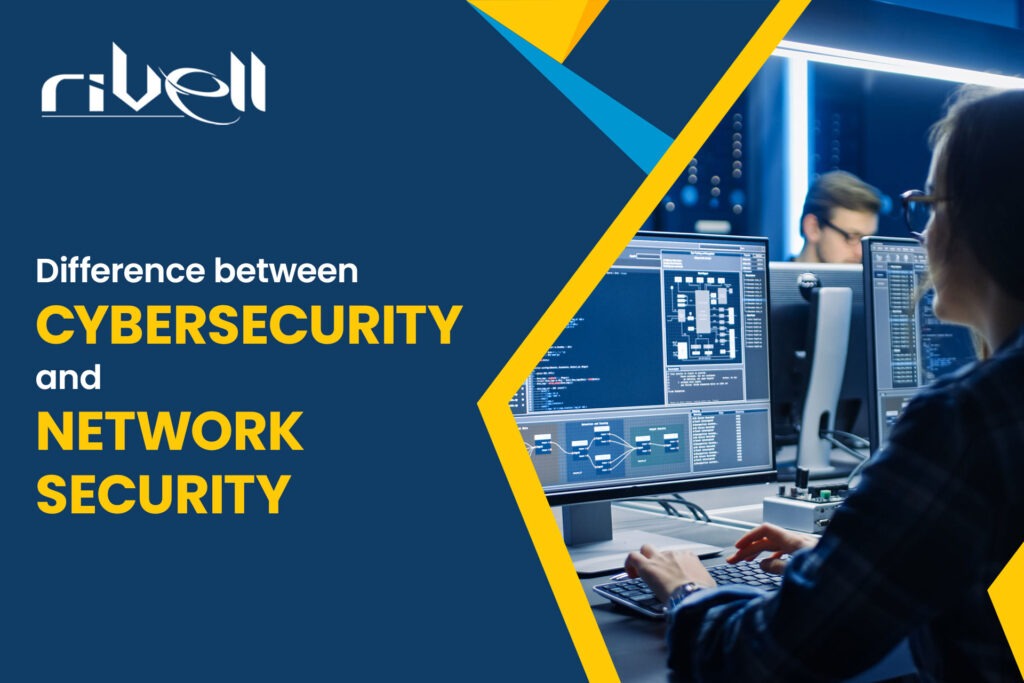In the ever-evolving landscape of digital threats and technological advancements, the terms “cybersecurity” and “network security” are often used interchangeably, creating a common misconception that they refer to the same thing. However, these two concepts, while related, have distinct focuses and play crucial roles in safeguarding our digital world.
Cyber Security
Cybersecurity is a comprehensive term that encompasses the protection of computer systems, networks, and data from theft, damage, or unauthorized access. It is a broad field that addresses the entirety of the digital landscape, including computers, servers, mobile devices, and the vast network of interconnected systems. Cybersecurity statistics indicate that there are 2,200 cyber attacks per day, with a cyber attack happening every 39 seconds on average.
In the US, a data breach costs an average of $9.44M, and cybercrime is predicted to cost $8 trillion by 2023.
Cybersecurity: The Holistic Guardian
1. Scope
Cybersecurity casts a wide net, covering all aspects of digital security. It involves safeguarding not only networks but also devices, applications, and data, recognizing that threats can emerge from various sources and attack vectors.
2. Layers of Defense
In the realm of cybersecurity, a multi-layered approach is crucial. This includes but is not limited to antivirus software, firewalls, intrusion detection systems, encryption, and security awareness training for users.
3. Risk Management
Cybersecurity is inherently linked to risk management. It involves identifying potential threats and vulnerabilities, assessing their impact, and implementing measures to mitigate risks. This proactive approach is essential in an environment where new threats constantly emerge.
Advantages of Cyber Security
- Holistic Protection: Cybersecurity provides a comprehensive approach to digital security, safeguarding not only networks but also devices, applications, and data.
- Risk Management: It involves proactive risk management, identifying potential threats, assessing their impact, and implementing measures to mitigate risks.
- Multi-Layered Defense: Cybersecurity employs a multi-layered defense mechanism, including antivirus software, firewalls, encryption, and security awareness training for users.
Disadvantages of Cyber Security
- Complexity: The broad scope of cybersecurity can lead to complexity in implementation and management, requiring a comprehensive understanding of diverse security measures.
- Resource Intensive: Implementing and maintaining robust cybersecurity measures may be resource-intensive, requiring significant financial and human resources.
- Constant Evolution: Cybersecurity strategies must constantly evolve to counter emerging threats, making it challenging to stay ahead of the rapidly changing threat landscape.
Read More : Cyber Security Tips for Small businesses
Network Security
Network security, on the other hand, is a subset of cybersecurity that specifically deals with the protection of a computer network infrastructure. This includes the measures taken to prevent unauthorized access, misuse, modification, or denial of a computer network and its resources.
Network Security: Safeguarding the Digital Highways
1. Focus
Network security, as a subset, narrows its focus to the protection of the infrastructure that facilitates communication and data transfer between devices within a network. This includes routers, switches, firewalls, and other network devices.
2. Access Control
One of the primary objectives of network security is controlling access to the network. This involves authentication processes, authorization levels, and encryption to ensure that only authorized users have access to specific resources.
3. Threat Prevention
Network security aims to prevent unauthorized access and attacks such as Distributed Denial of Service (DDoS) attacks, Man-in-the-Middle (MitM) attacks, and other network-specific threats. Measures like firewalls, intrusion detection systems, and virtual private networks (VPNs) are integral components.
Advantages of Network Security
- Focused Protection: Network security offers a focused approach to protecting the infrastructure that facilitates communication and data transfer within a network.
- Access Control: It involves stringent access control measures, including authentication processes, authorization levels, and encryption, ensuring that only authorized users have access to specific resources.
- Threat Prevention: Network security is specifically designed to prevent network-specific threats, such as DDoS attacks and Man-in-the-Middle attacks, enhancing the overall resilience of the network.
Disadvantages of Network Security
- Limited Scope: Network security, while crucial for protecting data in transit, has a more limited scope compared to the broader coverage of cybersecurity.
- Overemphasis on Perimeter Defense: Depending solely on network security may lead to an overemphasis on perimeter defense, overlooking internal threats and vulnerabilities.
- Rigid Policies: Strict network security policies may sometimes hinder the flexibility required for seamless collaboration and data sharing within an organization.
Difference between Cyber security and Network Security
| Aspect | Cybersecurity | Network Security |
| Scope | Encompasses a broad spectrum of digital security measures, including devices, applications, and data. | Focuses specifically on safeguarding the infrastructure that facilitates communication and data transfer within a network. |
| Layers of Defense | Employs a multi-layered approach, including antivirus software, firewalls, encryption, and security awareness training. | Utilizes measures such as firewalls, intrusion detection systems, and virtual private networks (VPNs) to protect the network infrastructure. |
| Risk Management | Proactively identifies potential threats, assesses their impact, and implements measures to mitigate risks. | Focuses on preventing unauthorized access, misuse, modification, or denial of a computer network, contributing to overall risk reduction. |
| Flexibility | Offers a holistic and adaptable approach to digital security, addressing diverse threats and attack vectors. | Provides a focused defense mechanism for the network but may sometimes lead to rigid policies that hinder flexibility. |
| Resource Intensity | Implementation and maintenance may be resource-intensive, requiring significant financial and human resources. | While still resource-intensive, network security’s more focused scope may result in slightly less resource demand. |
| Constant Evolution | Must constantly evolve to counter emerging threats in the dynamic digital landscape. | Adapts to emerging network-specific threats, but the scope is more contained, allowing for slightly more targeted adjustments. |
Frequently Asked Questions
1. What is the difference between cybersecurity and computer security?
Cybersecurity is a broader term that encompasses the protection of systems, networks, and programs from digital attacks, theft, and damage. Computer security focuses specifically on safeguarding individual computer systems and their data.
2. What are the 5 types of network security?
- Firewalls: Monitor and control incoming/outgoing network traffic.
- Antivirus/Anti-malware: Detect and remove malicious software.
- Intrusion Detection Systems (IDS) and Intrusion Prevention Systems (IPS): Identify and prevent unauthorized access or attacks.
- Virtual Private Networks (VPNs): Securely connect remote users to a private network.
- Access Control: Regulate who can access what within a network.
3. Does cybersecurity include networking?
Yes, cybersecurity includes networking as it involves protecting networks, systems, and data from cyber threats. Networking is a crucial component of cybersecurity, addressing vulnerabilities and ensuring secure communication.
4. Which is better: cybersecurity or networking?
Cybersecurity and networking are interconnected fields. If you enjoy designing and managing networks, focus on networking. If you’re passionate about protecting systems and data from cyber threats, delve into cybersecurity. Often, professionals in one area benefit from understanding the other.
5. How does networking relate to cybersecurity?
Networking is integral to cybersecurity as it forms the foundation for digital communication. Secure and efficient networking is crucial for implementing cybersecurity measures. Cybersecurity professionals need to understand network architecture, protocols, and vulnerabilities to devise effective strategies against cyber threats.
Conclusion
In the complex realm of digital security, understanding the nuanced differences between cybersecurity and network security is imperative. While cybersecurity takes a holistic approach, safeguarding the entire digital ecosystem, network security focuses specifically on protecting the pathways within that ecosystem. Their symbiotic relationship creates a unified front against digital threats, emphasizing the need for a balanced and comprehensive security strategy.
As technology continues to advance and threats become more sophisticated, organizations must recognize the unique advantages and disadvantages of both cybersecurity and network security. By doing so, they can formulate a robust defense strategy that not only protects their digital assets but also fosters adaptability in the face of an ever-evolving threat landscape. Ultimately, the synergy between cybersecurity and network security paves the way for a secure and resilient digital future.
If you are on the lookout for top-notch cybersecurity services that go beyond the ordinary, look no further than Rivell. Get in touch with Rivell today and elevate your cybersecurity defenses to new heights.









